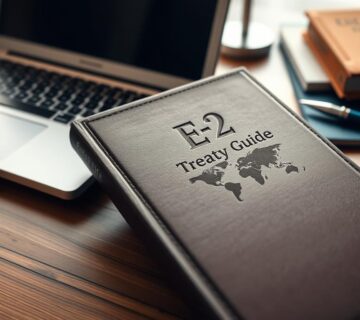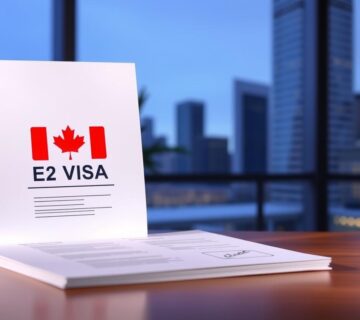Did you know that over 200,000 E1 and E2 visas are issued annually to nationals of treaty countries? These visas provide a pathway for foreign nationals to engage in international trade or invest in businesses within the United States. However, navigating the complexities of these visa categories can be challenging without a clear understanding of their distinct requirements and benefits.
The E1 visa is specifically designed for treaty traders, focusing on facilitating international trade between the U.S. and the applicant’s home country. On the other hand, the E2 visa caters to treaty investors who wish to invest substantial capital in a U.S.-based enterprise. Both visa types share some commonalities, such as the requirement to originate from a treaty country and the need for meticulous documentation, but their purposes and eligibility criteria differ significantly.
Historically, the U.S. government has maintained stringent requirements for both E1 and E2 visas, ensuring that applicants demonstrate either substantial trade volumes or a significant investment in a U.S. business. These requirements are designed to promote economic growth and maintain the integrity of the visa programs. Understanding these definitions and eligibility criteria is crucial for applicants to navigate the application process effectively.
In this article, we will delve into the key differences between E1 and E2 visas, exploring their eligibility criteria, investment requirements, and application processes. Whether you are a business owner looking to expand into the U.S. market or an investor seeking new opportunities, this guide will provide the clarity you need to make informed decisions. Lexology offers additional insights into the legal aspects of these visas, while Sohi Law Group provides expert guidance on immigration processes.
By the end of this article, you will have a comprehensive understanding of the U.S. visa application components, the trade focus of the E1 visa, and the investment requirements of the E2 visa. This knowledge will empower you to choose the right visa category for your business goals and ensure a smooth application process.
Understanding E Visa Basics
International trade and investment opportunities in the U.S. are made accessible through E1 and E2 visas, each tailored to distinct purposes. The E1 visa facilitates trade between the U.S. and a treaty country, while the E2 visa enables investment in a U.S.-based enterprise. Both require nationals from treaty countries, ensuring economic engagement.
Defining E1 and E2 Visas
E1 visas are for treaty traders conducting substantial trade, primarily between the U.S. and their home country. E2 visas target investors who control at least 50% of a U.S. business, requiring significant capital investment. Both visas offer renewable stays, enhancing business continuity.
Role of Treaty Countries and Eligibility
Treaty countries are crucial for E1 and E2 eligibility. The U.S. Department of State verifies nationality and business activities, ensuring they meet visa requirements. Trade must be principal for E1, while E2 demands a viable business plan and investment.
| Visa Type | Purpose | Key Requirements |
|---|---|---|
| E1 | Trade | 50%+ trade with the U.S. |
| E2 | Investment | 50% ownership; significant investment |
Understanding these basics helps applicants navigate the complex visa process, ensuring compliance and informed decisions.
Eligibility and Investment Requirements
Understanding the eligibility criteria and investment benchmarks is crucial for applicants seeking E1 or E2 visas. Both categories have distinct requirements, ensuring alignment with U.S. economic goals.
E1 Treaty Trader Criteria
The E1 visa is designed for treaty traders engaged in substantial international trade. At least 51% of the trade volume must be between the U.S. and the applicant’s home country. This trade must be ongoing and substantial, demonstrating a significant and continuous flow of goods, services, or technology. For example, an applicant from Canada must show that more than half of their business activities involve U.S. trade.
E2 Treaty Investor Criteria
E2 visas require a significant investment in a U.S. enterprise, typically exceeding $100,000. Applicants must own at least 50% of the business or hold a managerial role. The investment must be in a viable, active enterprise, not a passive investment like real estate. For instance, purchasing a stake in a U.S. tech startup qualifies, while buying rental properties does not.
Both visas demand meticulous documentation. E1 applicants must provide trade records, while E2 investors need financial statements and business plans. Sohi Law Group offers expert guidance on navigating these requirements. The investment must be “at risk,” meaning it could be lost if the business fails, ensuring a genuine commitment to the enterprise’s success.

what is the difference between e1 and e2 visa
Understanding the distinctions between E1 and E2 visas is essential for applicants seeking to engage in international trade or investment in the U.S. These visas cater to different business activities, each with unique requirements and processes.
Trade Focus vs. Investment Focus
The E1 visa is tailored for treaty traders engaged in substantial international trade. At least 51% of the trade volume must be between the U.S. and the applicant’s home country, such as Canada. This trade must be ongoing and substantial, involving goods, services, or technology.
In contrast, the E2 visa is designed for treaty investors who invest significant capital in a U.S. enterprise. While there’s no fixed amount, the investment must be substantial relative to the business’s total cost. The applicant must own at least 50% of the business or hold a managerial role.
Documentation and Process Distinctions
E1 applicants must provide detailed trade records, including invoices and shipping documents, to demonstrate the required trade volume. E2 applicants, on the other hand, need to submit financial statements, a viable business plan, and proof of their investment. Legal expertise, such as from immigration attorneys, can help navigate these complex requirements.

Understanding these distinctions is crucial for a smooth application process. Whether you’re a trader or investor, choosing the right visa ensures compliance and supports your business goals in the U.S.
Navigating the E Visa Application Process
Applying for an E visa involves two primary pathways: consular processing and change of status. Each method has its advantages and challenges, making it crucial to choose the right one for your situation.
Consular Processing versus Change of Status
Consular processing requires applicants to apply at a U.S. embassy or consulate abroad. This method is ideal for those outside the U.S. or seeking a longer stay. Change of status, on the other hand, allows individuals already in the U.S. to switch to an E visa without leaving the country, offering convenience but typically resulting in a shorter initial stay.
Expert Tips from Raman Sohi at Sohi Law Group
Raman Sohi, an immigration expert at Sohi Law Group, emphasizes the importance of understanding both pathways. “Choosing the right process can significantly impact your business goals,” he advises. Sohi recommends consulting with immigration attorneys to navigate document preparation and interviews effectively.
For personalized guidance, contact Sohi Law Group at 833-877-9797. Their expertise can streamline your application process and improve success rates.

Conclusion
In conclusion, the E1 and E2 visas offer distinct opportunities for nationals of treaty countries to engage in international trade or invest in the United States. The E1 visa is tailored for treaty traders, requiring substantial trade volume with the U.S., while the E2 visa is designed for investors who commit significant capital to a U.S.-based enterprise. Both require meticulous documentation and adherence to specific eligibility criteria to ensure compliance with U.S. immigration regulations.
Understanding the differences in documentation and application pathways is crucial. Applicants must choose between consular processing or change of status, each with its own timeline and requirements. Given the complexity, seeking expert legal guidance from reputable firms like Sohi Law Group can streamline the process and improve success rates.
For personalized assistance, contact Sohi Law Group at 833-877-9797. Their expertise ensures a smooth application process, helping you achieve your business goals in the U.S. with confidence.





No comment